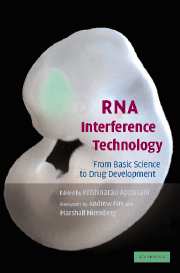Book contents
- Frontmatter
- Contents
- Foreword by Andrew Fire
- Foreword by Marshall Nirenberg
- List of Contributors
- Introduction
- Section one Basic RNAi, siRNA, microRNAs and gene-silencing mechanisms
- Section two Design, synthesis of siRNAs
- 6 Design and synthesis of small interfering RNA (siRNA)
- 7 Automated design and high throughput chemical synthesis of siRNA
- 8 Rational design of siRNAs with the Sfold software
- 9 Enzymatic production of small interfering RNAs
- Section three Vector development and in vivo, in vitro and in ovo delivery methods
- Section four Gene silencing in model organisms
- Section five Drug target validation
- Section six Therapeutic and drug development
- Section seven High-throughput genome-wide RNAi analysis
- Index
- Plate section
- References
8 - Rational design of siRNAs with the Sfold software
Published online by Cambridge University Press: 31 July 2009
- Frontmatter
- Contents
- Foreword by Andrew Fire
- Foreword by Marshall Nirenberg
- List of Contributors
- Introduction
- Section one Basic RNAi, siRNA, microRNAs and gene-silencing mechanisms
- Section two Design, synthesis of siRNAs
- 6 Design and synthesis of small interfering RNA (siRNA)
- 7 Automated design and high throughput chemical synthesis of siRNA
- 8 Rational design of siRNAs with the Sfold software
- 9 Enzymatic production of small interfering RNAs
- Section three Vector development and in vivo, in vitro and in ovo delivery methods
- Section four Gene silencing in model organisms
- Section five Drug target validation
- Section six Therapeutic and drug development
- Section seven High-throughput genome-wide RNAi analysis
- Index
- Plate section
- References
Summary
Introduction
In eukaryotic organisms, RNA interference (RNAi) is the sequence-specific gene silencing that is induced by double-stranded RNA (dsRNA) homologous to the silenced gene. In the cytoplasm of mammalian cells, long dsRNAs (>30 nt) can activate the potent interferon and a protein kinase-mediated pathway, which lead to non-sequence-specific effects that can include apoptosis (Kumar and Carmichael, 1998). Elbashir and coworkers (2001a) made the important discovery that small interfering RNAs (siRNAs) of about 21 nt specifically inhibit gene expression, because siRNAs are too short to activate the interferon or protein kinase pathway. The silencing by synthetic siRNAs is transient. This limitation can be overcome by stably expressed short hairpin RNAs (shRNAs), which are processed by Dicer into siRNAs (Paddison et al., 2002; Brummelkamp et al., 2002). However, it was recently reported that shRNA vectors can induce an interferon response (Bridge et al., 2003).
Because target recognition presumably depends on Watson-Crick base pairing, the RNAi machinery is widely believed to be exquisitely specific. As a reverse genetic tool, RNAi has set the standard in high-throughput functional genomics (Barstead, 2001; Tuschl, 2003). RNAi has also become an important tool in the identification and validation of drug targets in preclinical therapeutic development (Thompson, 2002; Appasani, 2003). Furthermore, RNAi-based human therapeutics are under development.
Initial empirical rules have been established by the Tuschl lab for the design of siRNAs. However, large variation in the potency of siRNAs is commonly observed, and often only a small proportion of the tested siRNAs are effective.
- Type
- Chapter
- Information
- RNA Interference TechnologyFrom Basic Science to Drug Development, pp. 129 - 138Publisher: Cambridge University PressPrint publication year: 2005
References
- 5
- Cited by

